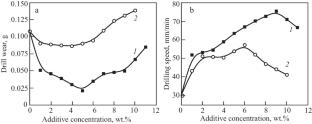The vacuum impregnation method was employed to produce two batches of tubular drills, incorporating AS200 500/400 diamond grains in a Cu–15 wt.% Sn metal matrix. In one batch, ASM 1/0 ultradispersed diamond powders (UDDPs) were added as a reinforcement to matrices in some tools. In the other batch, the reinforcement was tin. The concentration of ASM 1/0 additives ranged from 1 to 11 wt.% and that of tin from 1 to 10 wt.%. Comparative laboratory tests for drilling porcelain, granite, and SiC-based abrasive stone were conducted using these diamond drills. Performance characteristics such as drill wear and drilling speed were examined. The hardness of matrix samples containing additives, but without AS200 500/400 diamond grains, produced by the vacuum fusion method was determined. In drilling the examined materials, UDDPs reduced the wear of diamond drills through the reinforcing effect and increased matrix hardness. The optimal concentration of UDDPs was found to be 5 wt.% (9 wt.% for porcelain). A further increase in the concentration of such additives led to higher wear of the drills as porosity that appeared in the matrix reduced diamond grain retention. The addition of tin to the matrix also decreased the wear of diamond drills, with the minimum wear observed when approximately 4 wt.% Sn was introduced into the matrix. Increasing the tin concentration in the matrix beyond this point resulted in higher drill wear because of brittle intermetallics, which also reduced the strength of diamond retention. The diamond drills with UDDP additives exhibited higher drilling speeds that those with tin additives. Furthermore, the drilling speed for porcelain and granite decreased with the introduction of tin up to 4 wt.% because of the ‘blunting’ effect. The diamond drills with a UDDP-reinforced matrix demonstrated better performance characteristics, including reduced wear and higher drilling speed.



